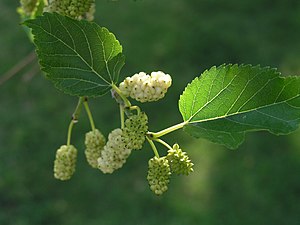White mulberry
| White mulberry | ||||||||||||
|---|---|---|---|---|---|---|---|---|---|---|---|---|

White Mulberry ( Morus alba ), fruits |
||||||||||||
| Systematics | ||||||||||||
|
||||||||||||
| Scientific name | ||||||||||||
| More alba | ||||||||||||
| L. |
The white mulberry ( Morus alba ) is a plant from the genus of mulberry ( Morus ) within the family of Mulberry family (Moraceae). It comes from China and is used in many ways.
description
The white mulberry grows as a deciduous tree and reaches heights of 1 to 16 meters. The bark is matt gray-green to reddish brown, dark orange-brown on old trees. The crown is high and rather narrow, branches are noticeably often broken; sometimes the crown is also lower and arched. The bark of the thin, straight branches is initially finely haired.
The leaf shape is very variable; there are irregularly lobed, split and undivided leaves on the same tree; the leaves are blunt to heart-shaped at the base, most are ovate and pointed to acuminate. The leaves are divided into a petiole and a leaf blade. The leaf stalk is up to 5 cm long, furrowed and slightly hairy. The leaf blades are usually up to 10 cm long and 8 cm wide, some up to 20 cm long and 12 cm wide; at the edge they are roughly toothed or sawed; the leaf veins are hairy on the underside of the leaf. Small stipules are present.
Smaller female and larger male kittens are formed.
The anthers dust their pollen out here using a special centrifugal mechanism caused by the upward-running stamens.
The fruits ( fruit cluster ) are white, later yellowish, but often also pink to purple in color. Small, brownish achenes are formed.
The number of chromosomes is 2n = 14, 28 or 42.
ingredients
The leaves contain 4-, 5- hydroxypipecolic acid. When the leaves are infected with the fungus Fusarium solani , moracins are formed as phytoalexins . In the timber comes Morin comprising, as reagent different for the detection of cations can be used. Mulberrofurans occur in the bark as partially colored lignans .
distribution
The white mulberry was native to China before it was cultivated by humans . Since it is the most important mulberry species for breeding silkworms , it is also planted in many other climatically suitable regions outside of China. In Germany it is not only found quite often in parks, but also occasionally as a hedge.
In southern Europe as well as in parts of Germany there are mulberry trees that were planted until the beginning of the 20th century in order to use the leaves for sericulture.
use
The white mulberry is the most important mulberry species for silkworm breeding .
Since the edible fruits are not durable, they are only offered in shops - if at all - in dried form . The taste of the white mulberries is very juicy and sweet. In Anatolia, syrup is also obtained from the juice, which is used as a remedy for various minor ailments or as a spread.
Cultivated forms
- 'Fruitless': a male form that does not grow fruit.
- 'Laciniata': This form has very deeply incised leaves.
- 'Mapleleaf': A male form that does not set any fruit. The deeply lobed leaves are reminiscent of maple leaves.
- 'Nuclear Blast': The leaves of this shape are reduced to fringes and ribbons; the bush appears sick and stunted; the English name of the variety alludes to this appearance ("like after radioactive contamination").
- 'Pendula': In this form, all branches are hanging. It grows as a small tree with an umbrella-shaped crown. The leaves are about 20 cm long and 12 cm wide, much larger than the type. Fruits are formed.
- 'Urbana': A hanging shape similar to 'Pendula', but which does not produce any fruit.
Others
The fruits, which ripen from June, sometimes fall from the tree when they are green and are eaten by ducks, for example.
swell
- Alan Mitchell, translated and edited by Gerd Krüssmann: The forest and park trees of Europe: An identification book for dendrologists and nature lovers . Paul Parey, Hamburg and Berlin 1975, ISBN 3-490-05918-2 .
- Römpp: Lexicon of Natural Products. Georg Thieme Verlag, 1997, ISBN 3-13-749901-1 (sections description and types).
- Datasheet from the Center for New Crops & Plants Products at Purdue University. (Sections Description and Varieties).
- Morus alba in the Flora of North America, Vol. 3.
Individual evidence
- ↑ Aimée Sakes, Marleen van der Wiel, Paul WJ Henselmans et al .: Shooting Mechanisms in Nature: A Systematic Review. In: PLOS ONE . 11 (7), 2016, e0158277, doi : 10.1371 / journal.pone.0158277 .
- ^ Erich Oberdorfer : Plant-sociological excursion flora for Germany and neighboring areas . 8th edition. Verlag Eugen Ulmer, Stuttgart 2001, ISBN 3-8001-3131-5 , p. 320.
Web links
- More alba at Plants For A Future
- Morus alba L. In: Info Flora , the national data and information center for Swiss flora . Retrieved October 4, 2015.
- Thomas Meyer: Data sheet with identification key and photos at Flora-de: Flora von Deutschland (old name of the website: Flowers in Swabia )
- Data sheet at hort.uconn.edu. (engl.)
- Entry at desert-tropicals . (engl.)
- Datasheet at baumkunde.de .



